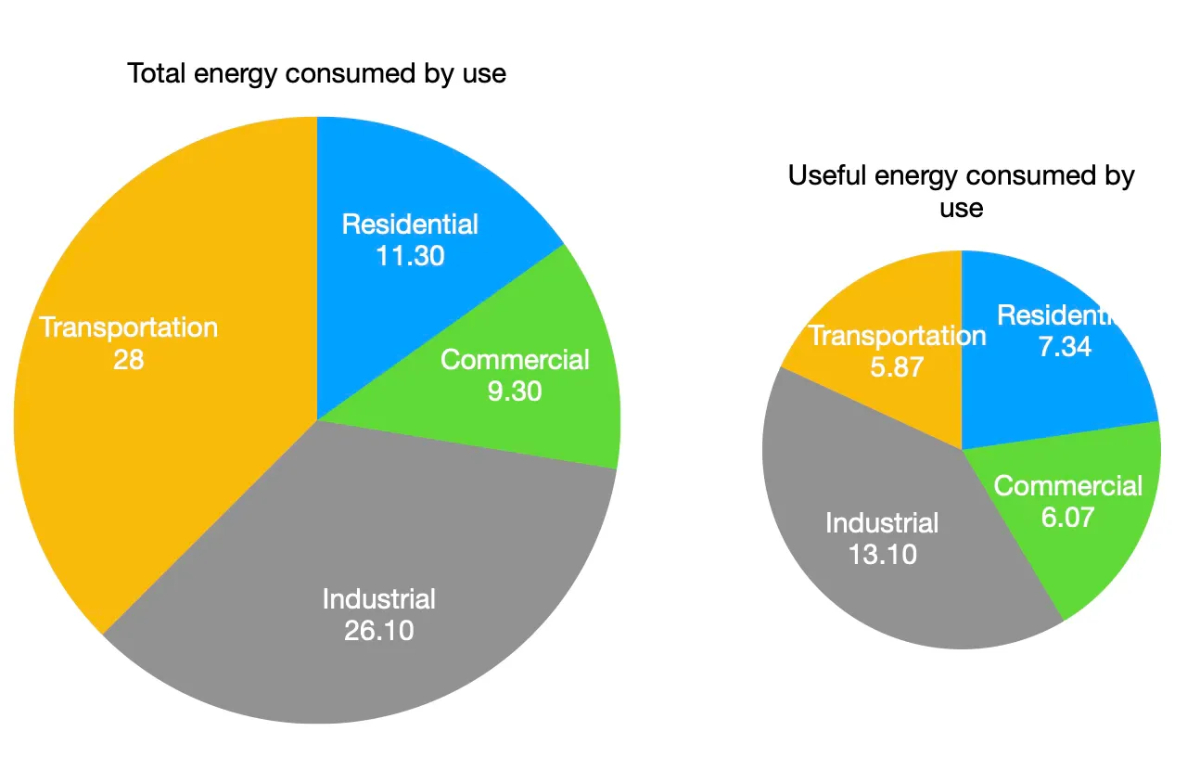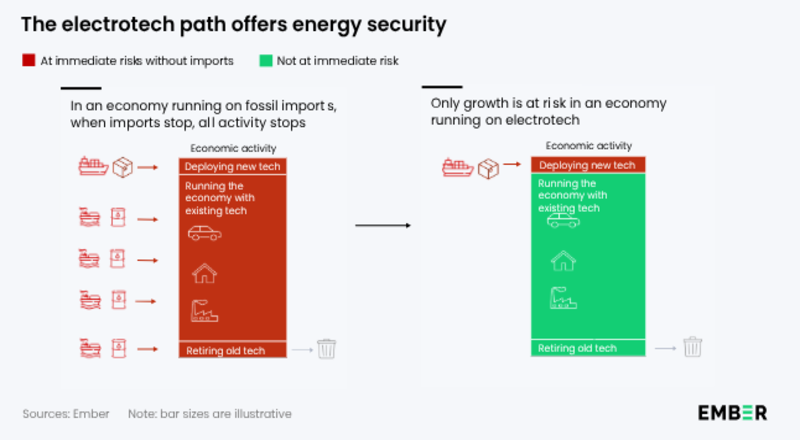Support CleanTechnica’s work through a Substack subscription or on Stripe.
Hello, CleanTechnica readers. Here are a few questions that I think will help clarify why electric cars, renewable energy, and low carbon process heat technologies will carry the day — eventually.
If you are in an emergency room, and have four pints of blood available, would you pour two of them down the drain?
If you are a firefighter and have 1000 gallons of water available to put out a blaze, would you let 500 gallons run into the street?
If you have a gallon of milk in your refrigerator, would you pour half of it into another container and throw the rest away?
If you are driving a car with a 10-gallon gas tank, would you let 7 of those gallons leak out onto the pavement?
Silly questions, I know. Nobody in their right mind would do any of those things, but in fact, people all over the world pay for gasoline every day to power vehicles that in some cases are only 15% efficient. That’s right, if you are paying $3.00 a gallon for gas today, less than $0.50 actually goes to move your car forward. The rest goes out the tailpipe or into the atmosphere as heat.
This was brought home to us recently by Lloyd Alter, the sage of Toronto, who posted on Substack the latest news from Ember that shows exactly how wasteful burning fossil fuels actually is. Alter has addressed this issue before — including in his book, The Story Of Carbon Upfront, in which he quotes economist Robert Ayers, who wrote:
“The economic system is essentially a system for extracting, processing and transforming energy as resources into energy embodied in products and services.” Alter sums it up in his own words this way: “The purpose of the economy is to turn energy into stuff. Ayres doesn’t have much time for traditional economics, but teaches that economics is subject to the laws of thermodynamics, which is very convenient when thinking of energy and carbon. Those economic processes consume energy and turn it into goods and services, waste heat, upfront carbon emissions, and eventually landfill.”
Wasting Fossil Fuel Is Big Business
The secret that nobody wants to hear about fossil fuel companies is that they want us to waste as much energy as possible — not little dribs and drabs like water dripping from a leaky faucet, but huge amounts every hour or every day, 365 days a year. That waste is what powers their quest for new oil and gas deposits that can be extracted, refined, distributed, and burned to create ever more profits — and waste.
It’s a form of madness, but we have been conditioned to believe the madness is necessary because it is the source of our advanced lifestyle. Chris Wright, the methane billionaire who is now the Energy Secretary, is running around loose telling everyone that fossil fuels are responsible for the fact that people are living longer today than they did a century ago. And yet, as Paul Krugman has pointed out, life expectancy in the US rose even during the period when asbestos was widely used.
Alter points out that people are always saying the transition to renewable energy can never happen because the world needs so much electricity that transitioning to renewables is impossible. And yet, the latest Ember report reveals something quite startling. If we eliminate the energy waste built into the fossil fuel model, the goal of a what Ember calls The Electrotech Revolution is well within reach.
“To understand why the electrotechnical revolution will happen, you have to understand the primary energy fallacy, where we are told that we cannot possibly replace all the energy we get from coal or oil,” Alter writes. “In fact, we don’t have to. We just have to replace the useful energy. Heat engines cannot be very efficient, as proven by Sadi Carnot. Electric motors can approach 100%.
 Credit: Lloyd Alter, Carbon Upfront.
Credit: Lloyd Alter, Carbon Upfront.
Alter has created two pie charts based on data from the Livermore National Laboratory which show that when we electrify everything, we no longer need to account for waste heat. That data shows the US currently consumes about 75 quads of energy every year (a quad is equal to a quadrillion BTUs). But subtracting waste heat from the equation shows the US only needs less than half that amount — 32.38 quads — to accomplish exactly the same result. It already has about 16 quads of renewables available, which means it only needs another 16 quads more to meet current energy demand. He points out that China has already added 5 quads of renewable energy this year alone.
Of course, the wild card here is AI and data centers, which threaten to gobble up several quads of energy all by themselves, unless ways can be found to reduce their voracious appetite for energy. That issue is creating a great deal of debate nationally, with PJM, the largest grid operator in the US, announcing recently that data centers will need to provide their own sources of electrical energy in order to keep other rate payers from having to pay for the upgrades in generation and transmission that will be needed.
The Electrotech Revolution
In the executive summary to its latest report, Ember says, “The electrotech revolution is the most profound transformation of the energy system since the shift from biomass to fossil fuels in the 18th century. As electrotech costs fall and exponential growth continues, a century of evolution is converging into a decade of revolution.”
It also focuses on the issue of energy security. “80% of the world lives in fossil fuel importing countries, with over 50 countries importing more than half their primary energy as fossil fuels. In contrast, 92% of countries have renewables potential over ten times their current demand. Replacing imported fossil fuels using three key levers — EVs, heat pumps and renewables — can cut net fossil fuel imports by 70%, saving $1.3 trillion globally each year. Once electrotech is bought, it lasts for decades, providing insulation from the vagaries of global pricing. ”
In other words, if you want energy security, local renewable energy is the answer, not some LNG tanker plowing its way across the ocean (and burning fossil fuel every mile along the way). Stable prices for electricity are also a feature of renewables, since virtually all clean energy projects are tied to power purchase agreements that guarantee the price of electricity for anywhere from 15 to 30 years. 20 years is typical. Thermal generators can only wish for such price stability. In the US, the price of methane has increased about 40% in the past two years.
Ember concludes that 75% of the world’s energy demand can be electrified, and likely will be whether the US and Saudi governments like it or not. “Further innovation is chipping away at the final 25% in shipping, aviation and high temperature heat.”
Science makes clear that renewable energy is the most efficient way of producing electricity. Politics, which is distorted by money from the world’s most polluting corporations, favors wasting energy and letting prices rise. For some reason, people like to reject science and believe politicians at incalculable cost to themselves. Wasting half of all the energy extracted from the earth is senseless, so why do it?
Sign up for CleanTechnica’s Weekly Substack for Zach and Scott’s in-depth analyses and high level summaries, sign up for our daily newsletter, and follow us on Google News!
Advertisement
Have a tip for CleanTechnica? Want to advertise? Want to suggest a guest for our CleanTech Talk podcast? Contact us here.
Sign up for our daily newsletter for 15 new cleantech stories a day. Or sign up for our weekly one on top stories of the week if daily is too frequent.
CleanTechnica uses affiliate links. See our policy here.



